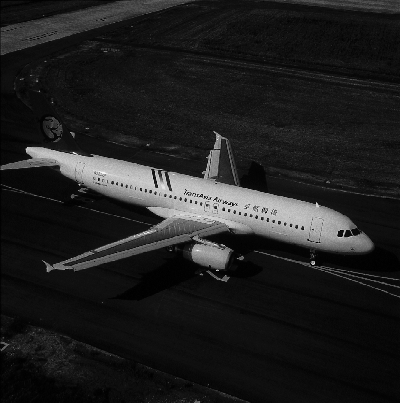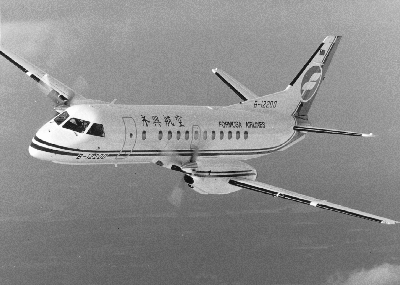Brent Hannon/TAIPEI
A series of fatal accidents has halted 11 years of rapid expansion by Taiwan's second-tier airlines, and an era of mergers and consolidation is at hand. The nine commercial airlines than once flew Taiwan's domestic skies will soon be cut to five, with further reductions likely.
EVA Airways has dropped all domestic routes, and has agreed to merge its three subsidiaries, UNI Air, Great China Airlines and Taiwan Airlines, into a single carrier to be called UNI Air. Far Eastern Air Transport, the largest and most profitable second-tier carrier, in February bought a 10% stake in TransAsia Airways' parent company, fuelling speculation of a merger between the two, which together operate 50% of Taiwan's domestic capacity.
China Airlines (CAL) is also looking at possible mergers, but its priority is to get subsidiary Formosa Airlines, grounded since March 19, back into the air, and to rebuild its own passenger traffic in the wake of the Airbus A300 crash that killed 202 people on 16 February.
TRAFFIC GROWTH
Before the accidents, domestic passenger traffic had grown by nearly 20% annually since deregulation in 1987. Nine airlines served the domestic market for most of the past decade, including international carriers CAL and EVA, with the growth encouraged by Taiwan's pro-competition Civil Aeronautics Administration (CAA).
But with many domestic airlines losing money, and the prospect of direct flights to China still remote, the CAA is urging them to consolidate. As an incentive, the CAA will allow a rise in air fares (now controlled in a flexible band) for those airlines that agree to a merger. The CAA also wants local airlines to reduce the number of flights between Taipei and Kaohsiung and between Taipei and Tainan. Six airlines now offer 100 round trips a day between Taipei and Kaohsiung, with average load factors around 60%.
"The market will shrink sharply," predicts Tony Lin, a Formosa Airlines executive. "The Government policy has changed - it will encourage mergers and cut frequencies to reduce air traffic congestion," he adds. The new policy is a cabinet-level decision, says Lin, and carries the full authority of the executive office.
With notable exceptions such as EVA Airways and Great China, Taiwan's airlines have poor safety records. The recent string of accidents began with the CAL crash on 16 February, and the latest fatality occurred on 18 March, when Formosa Airlines suffered its third fatal accident in two years with one of its Saab 340s crashing into the sea, killing all 13 on board. On 19 March, the CAA suspended all Formosa flights and the head of the CAA resigned, as has CAL's chairman C F Fu.
TRAIN BENFITS
As a result, domestic air traffic dropped, and train travel has risen by 20% since 18 March. Despite the grounding of Formosa and the removal of its 16 aircraft from the marketplace, Great China vice-president Charles Wu says load factors are 10-20% lower than normal, and Far Eastern Air Transport (FEAT) planning analyst Chris Lin reports a similar slowdown.
The newly merged UNI Air will give its international routes to parent airline EVA. UNI's overseas route include the island nation of Palau, Kota Kinabalu in Malaysia, and Laoag, in the Philippines.
"We've talked to UNI, Great China and Taiwan Airlines, and we have their full support for the merger," says EVA junior vice-president K W Nieh.
EVA will take delivery of all aircraft ordered by its subsidiaries, including a firm Great China order for six de Havilland Dash-8-400s, with six options, for delivery from early 1999, and a Taiwan Airlines order for two Fairchild Dornier 328s, for delivery in 1998.
The new UNI will reduce the number of aircraft types in its fleet. Nieh says UNI's Boeing MD-90s and British Aerospace 146s complement each other, and will remain in the fleet, but Taiwan Airlines' Pilatus Britten-Norman Islanders and Trislanders will probably be sold.
PERRENNIAL LOSER
UNI made a small profit in 1997, says Nieh, after losing money in 1995 and 1996. Great China lost NT$100 million ($3.1 million) in 1997, says Wu, but projects a small profit for 1998. Tiny Taiwan Airlines is a perennial money loser, but it could get a boost from Formosa Airline's plan to drop its loss-making outer island routes. Formosa's plan is not yet approved by the CAA.
The post-merger UNI Air will benefit from shared training, ticketing and maintenance facilities, a shared promotional budget, more airport slots and scheduling flexibility, and higher fares and load factors because of decreased competition and the pricing incentive from the CAA, says Nieh.
Jet operator FEAT will remain independent for now. "Consolidation won't have much affect on us - we are number one in domestic routes," says planning analyst Chris Lin.
FEAT controls 33% of the domestic market, enlisted last year on the Taiwan stock exchange, and in November 1997 signed a contract for five Boeing 757-200s, with five options. Delivery of the 757s will begin this year, and continue up to 2000. FEAT also flies to Guam, Palau, and Subic Bay in the Philippines. In 1996, FEAT had an operating profit of $10.2 million, and in 1997 posted a profit of $25 million.
Another large airline, TransAsia Airways, struggled with domestic load factors below 50% in the last quarter of 1997, and last year lost some $30 million. Only the addition of two new investors in 1997, and the sale and leaseback of several of its aircraft, kept the airline solvent.
TransAsia's routes to Macau remain profitable, but speculation centres around a possible merger with FEAT, fuelled by FEAT's February 1998 purchase of 10% of Gold Sun, parent company of TransAsia. "Ten percent of Gold Sun is big chunk of TransAsia," says Wu.
If FEAT and TransAsia were to merge, says Taipei aviation analyst Dan Hellberg, they would control half of domestic traffic. The new UNI would dominate much of the remaining market, presenting formidable competition for U-Land and Formosa/China Airlines.
Formosa Airlines' priority is to put its fleet back to work, says CAL. The CAA gave it permission to resume flights on 1 April, beginning with its Fokker 50s and Fokker 100s, then its Fairchild Dornier 228s, and finally its Saab 340s.
CAL purchased a 41% stake and took over management of Formosa in July 1996, with the aim of improving Formosa's safety record and using it to feed CAL's international flights. Even before the accidents, CAL vice-president of marketing and sales Sandy Liu had concluded that the feeder relationship with Formosa was not working.
"We tried to make Kaohsiung a feeder hub for our international operations, but the traffic was too small," Liu says. "And to CKS International, there's no frequency. It's better to fly to Taipei domestic airport and take the bus to CKS."
Formosa wants to merge with another airline, and the CAL board of directors is discussing options, but CAL could not speculate on possible outcomes. The CAA has suggested that CAL operate Formosa as its domestic arm. CAL also owns 10% of FEAT, and the China Development Corporation, which owns part of CAL, has a 10% stake in TransAsia.
DEVALUATION LOSS
Formosa would have made a profit in 1997, says Tony Lin, but the 20% devaluation of the Taiwan dollar caused it to lose $4.4 million. Formosa also must pay $302,000 in compensation to relatives of each of the 13 victims of its accident of 18 March 18, the same amount paid by CAL to relatives of each of the 202 victims of its crash on 16 February.
Before the accident, Formosa planned to buy two additional Fokker 100s, but has abandoned that idea, says Lin. When it terminates its outer island routes, the airline plans to sell its three remaining Fairchild Dornier 228s, and may also try to sell its remaining six Saab 340s, which it considers to be too small.
CAL will continue to fly its two domestic routes, from Taipei Domestic Airport to Kaohsiung, and from Kaohsiung to CKS International airport.
The final second-tier airline, U-Land, remains a pariah. Once a tiny airline with a single Shorts 360, it was bought in 1995 by Rui Lian construction company, which acquired six Boeing MD-82s and changed the name from China Asia Airlines. It has incurred the wrath of the CAA and other airlines for price dumping, selling one-way tickets on the Kaohsiung-Taipei route for as little as ó3. Most of the other domestic airlines hold U-Land responsible for their reduced profits or losses in 1996.
U-Land has entered into an arrangement with Astro Air of the Philippines, under which it wet-leases aircraft to the Philippine airline, and thus is able to fly international routes. Even before the downturn in domestic traffic, U-Land was operating in the red. "They lose money on every flight," says Wu. Meanwhile, the future looks bright for the airlines that emerge from the current slowdown and consolidation. Taiwan's economy remains strong, with gross domestic product projected to exceed 6% in 1998. The new five-day work week, which became law on 1 January, has given a boost to weekend leisure travel, as Taiwanese no longer have to work every Saturday morning.
Local travellers will take to the skies again, says Great China vice-president Charles Wu. "It takes time to recover, but people will soon forget the accidents," Wu says. His comment is echoed by several other airline executives. Some predict recovery could take several months, but none believes that the slowdown is permanent.
Nonetheless, Taiwan's decade-long era of cheap flights and massive frequencies is finished, as the number of airlines shrinks and aircraft size increases. Nieh envisions a future where rush hour flights from Taipei to Kaohsiung leave every 15min, instead of every 5min, boosting load factors and revenue for every remaining domestic airline.

TransAsia Airways struggled to stay afloat in 1997 and had to sell and leaseback aircraft
China Airlines is looking at mergers, but is focusing on getting subsidiary Formosa flying-

-as the CAA suspended all Formosa flights on 19 March after its third fatal accident in two years
| DOMESTIC FLEETS | ||
| FAR EASTERN AIR TRANSPORT | TAIWAN AIRWAYS | |
| 7 x Boeing MD-82 | 3 x Fairchild Dornier 228 | |
| 4 x Boeing MD-83 | 1 x Pilatus Britten-Norman 3 | |
| 2 x Boeing 737-200 | 3 x Pilatus Britten-Norman 2 | |
| 3 x Boeing 757-200 | Orders | |
| Orders | 2 x Fairchild Dornier 328, delivery in May and December | |
| 5 x Boeing 757-200 | ||
| 1 x Boeing MD-83, delivery in April | TRANSASIA AIRWAYS | |
| Options | 12 x AI(R) ATR-72 | |
| 5 x Boeing 757-200 | 5 x Airbus A320 | |
| 6 x Airbus A321 | ||
| FORMOSA AIRLINES | Orders | |
| 3 x Fairchild Dornier 228 | 2 x Airbus A320 | |
| 2 x Fokker 100 | 3 x AI(R) ATR-72 | |
| 5 x Fokker 50 | ||
| 6 x Saab 340 | U-LAND | |
| 6 x Boeing MD-82 | ||
| GREAT CHINA AIRLINES | ||
| 1 x Boeing MD-90-30 | UNI AIR | |
| 12 x de Havilland Dash-8-300 | 7 x Boeing MD-90-30 | |
| Orders | 5 x BAe 146-300 | |
| 6 x de Havilland Dash-8-400, delivery 1999 | ||
| Options | ||
| 6 x de Havilland Dash-8-400 | ||
Source: Flight International























